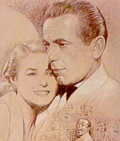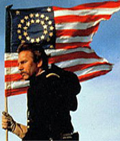Factual mistakes in Glory(1989)
-
Two of Frederick Douglass' sons fought with the 54th but were not included in the movie.
- The film suggests that most of the black soldiers were escaped slaves from southern secessionist states who wished to battle for the abolitionist north, but in fact the majority were born free in the North, although some did escape from slavery. 1
-
Of the major characters in the movie's version of the regiment, only Robert Gould Shaw was a real person. The rest are composite characters. The name of Shaw's executive officer (Cabot Forbes) is a combination of the first name from one of the real Shaw's friends and the last name of another. 1
- In the film, Shaw is offered and accepts the job to be the commanding officer of the 54th on the same day. In reality, he rejected the offer once and accepted only after many days. Shaw is also shown as promoted directly to colonel, whereas his record indicates he was a major for several months as the regiment grew in strength and was at last promoted to colonel just prior to the regiment being deployed. 1
- The incident just before the charge into Fort Wagner in which Colonel Shaw points to the flag bearer and asks "If this man should fall, who will lift the flag and carry on?" is based on a real event. However, the person who asked the question was General George Crockett Strong; Shaw was the person who responded. When the flag bearer fell, another black soldier, Sergeant William Harvey Carney, grabbed the flag and carried it all the way to the bulwarks of Fort Wagner. He remained there under enemy fire until the 54th was forced to retreat. Sergeant Carney struggled back to Union lines with the flag, receiving four wounds from which he recovered. Carney became the first black recipient of the Medal of Honor. 1
-
Colonel Shaw was married, but his wife is not depicted in the film.
The manner in which Colonel Shaw dies in the movie is based on fact. His final words were "Forward Fifty-fourth" before he was shot several times in the chest.
The final scene of the film shows Shaw's body being thrown into the burial pit alongside his fallen soldiers. This is historically accurate. It seems to have been meant as an insult, but Shaw's father later said that he was proud that his son was buried in such a manner. 1
- In the movie, it is claimed that "over half" of the regiment was lost during the assault on Fort Wagner. However, official records state that the 54th sustained 272 casualties, which is closer to 40%. Of these casualties, only 116 were fatalities, just under one fifth of the men to storm the fort. If you include the 156 soldiers that were captured, it would bring the total to "over half". 1
- In the movie, the ocean is on the left side of the regiment when they charge the fort; this was allegedly done in order to get the best quality of light at the time of filming. In reality, however, the regiment charged with the ocean on their right, coming from the south. 1
- The real second in command was Lt. Colonel Edwin Hallowell. The fictional Major Cabot Forbes, played by Cary Elwes, is based on him. Although he was seriously wounded, Hallowell did survive the attack on the fort and led the regiment until it disbanded in 1865. He retired with the rank of Brigadier General.
1
- In the movie, Shaw is surprised when the men refuse pay that was reduced because they are a "colored" regiment (though he eventually joins them in their refusal). In reality, the refusal was his idea, and he encouraged them to do it.
1
2 http://en.wikipedia.org/wiki/Glory_%28film%29, Wikipedia Article on Glory.
|

